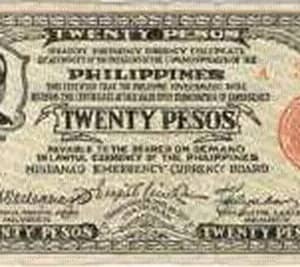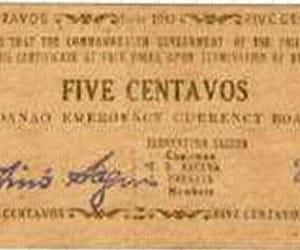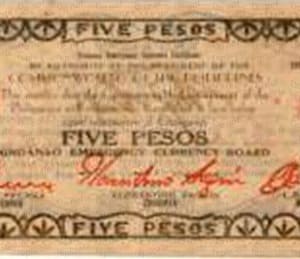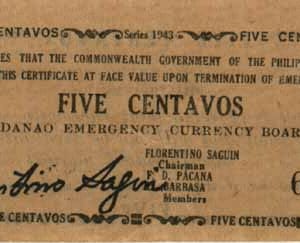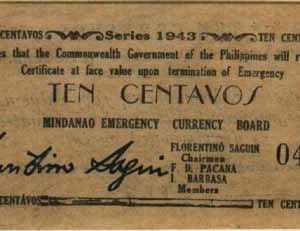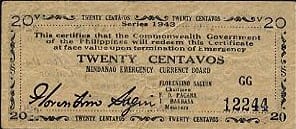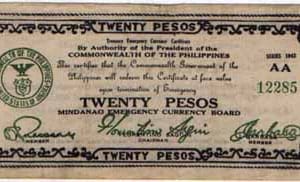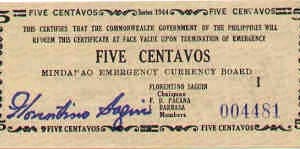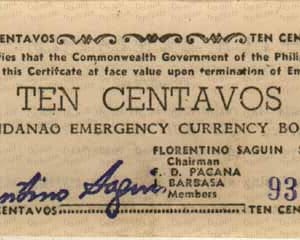Municipal notes:
- <em>There are no known municipal issues by this province.</em>
Provincial notes:
First Currency Board-
The Cebu Emergency Currency Board was established with the hope that it would be able to meet the printing needs of the whole Visayan Islands. This could not be done, so an additional Currency Board was established in Mindanao on March 16th, 1942.
Printing plates were made in Cebu City with the same design as the Cebu notes. The plates were transported to Dansalan, Lanao for printing. On May 1st, 1942 printing stopped when the Japanese invaded Mindanao. 1,769,690 Pesos were issued, including 20,000 of the 2 Pesos notes.
That night, finished 2 Pesos notes sheets (uncut), and many unfinished sheets of other denominations, as well as some of the printing equipment, were evacuated to Swagat. They were again moved to Tamparan on May 4th where the 2 Pesos note sheets were cut. These were serial numbers 20,001 to 90,000. These 2 Pesos notes were given to Mr. Donato Ducusin, Provincial Treasurer of Sulu. He was serving as Secretary of the Mindanao Emergency Currency Board. He was murdered by Moros a few days later, but the notes made it into circulation.
Second Currency Board-
After General Wainwright’s surrender orders, troops of the Visayan-Mindanao Force began surrendering on May 10th, 1942. The surrenders were not completed until May 27th, but by then thousands of soldiers had left to either hide or join guerrilla units.
In Lanao, Lt. Col. Wendell W. Fertig began orgainzing the various guerrilla units. He established the United States Forces In the Philippines (USFIP), Mindanao-Sulu Command and assumed the rank of Brigadier General.
Lt. Sam Wilson, who was in charge of printing the currency for the original Mindanao Emergency Currency Board, joined Fertig and notified him that Mindanao had not printed the entire amount of notes they were authorized to print. Permission was obtained from Quezon through MacArthur to reform the Currency Board.
Judge Florentino Sanguin was Chairman, Filomena D. Pacana and Oreneo Barbasa were members.
Major (field rank) Sam Wilson was assigned to resume the printing. Wood cuts were made for the face of the 2 Pesos note, as well as the front and back of the 10 and 20 Pesos notes. The 5 Pesos notes were printed from teh same plates that were used for Misamis Occidental. Other denominations were printed from metal plates.
The Rozito Z. Bacarro Press in Marigas, Jiminez, Misamis Occidental was where the notes were printed. Printing started on April 5th, 1943. On June 26th the Japanese invaded the area, and the printing press was hidden in the hills.
After this the press was put back together in Liangan. Printing resumed on September 6th, 1943 until November 1st, 1943 when they ran out of supplies. The press was moved again, this time to Esperanza. The USS NARWHAL had dropped off printing supplies, including 84 metal plates made in Australia. On December 13th, 1943 they resumed printing. The 5 centavos and 20 Pesos notes did not have new metal printing plates created for them, so the old ones were used.
The press was moved again to Loreto, Agusan in early February of 1944. Printing was resumed March 18th, 1944.
In July of 1944 Loreto was bombed. The printing press was hidden away again, and printing did not resume until November 4th, 1944.
During the last shut-down, Sam Wilson took a small group of people and some printing plates to Dipolog, Zamboanga. The trip took almost two months, at which point he resumed printing at Rev. Angel Soto Printing in Tingkugas on September 14th until they ran out of supplies on October 6th, 1944.
Printing resumed February 27th, 1945 once new paper was brought in again by submarine. When American forces landed at Dipolog on March 8th, 1945, the press was again moved. This time it was moved to Calamba, Misamis Occidental. Printing there occured from April 1st, 1945 through April 22nd, 1945. Col. Fertig ordered a stop on that date.
The only notes dated 1945 were printed back in Loreto, Agusan in early January 1945. They ran out of paper.

